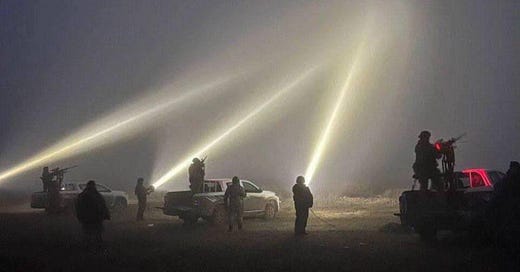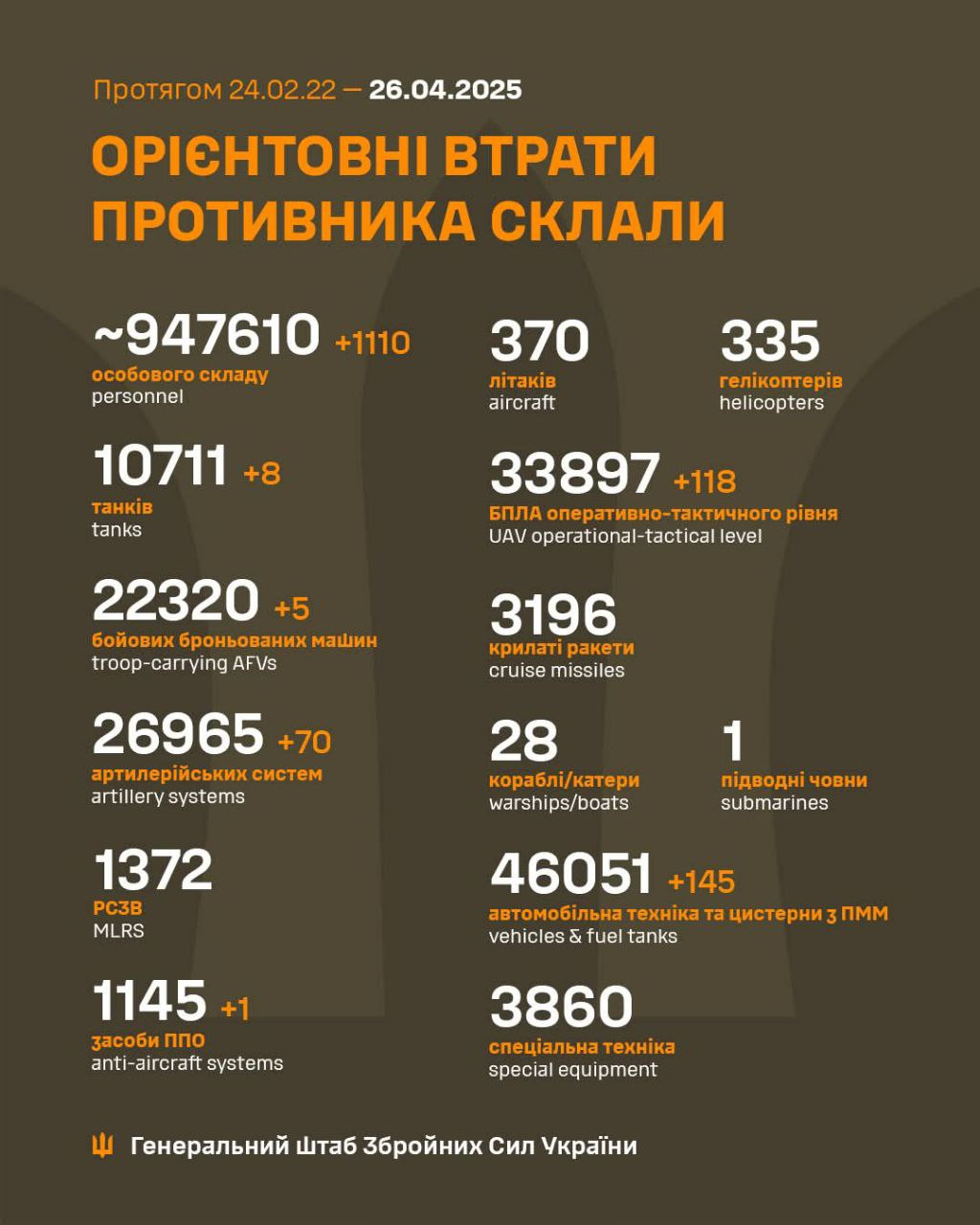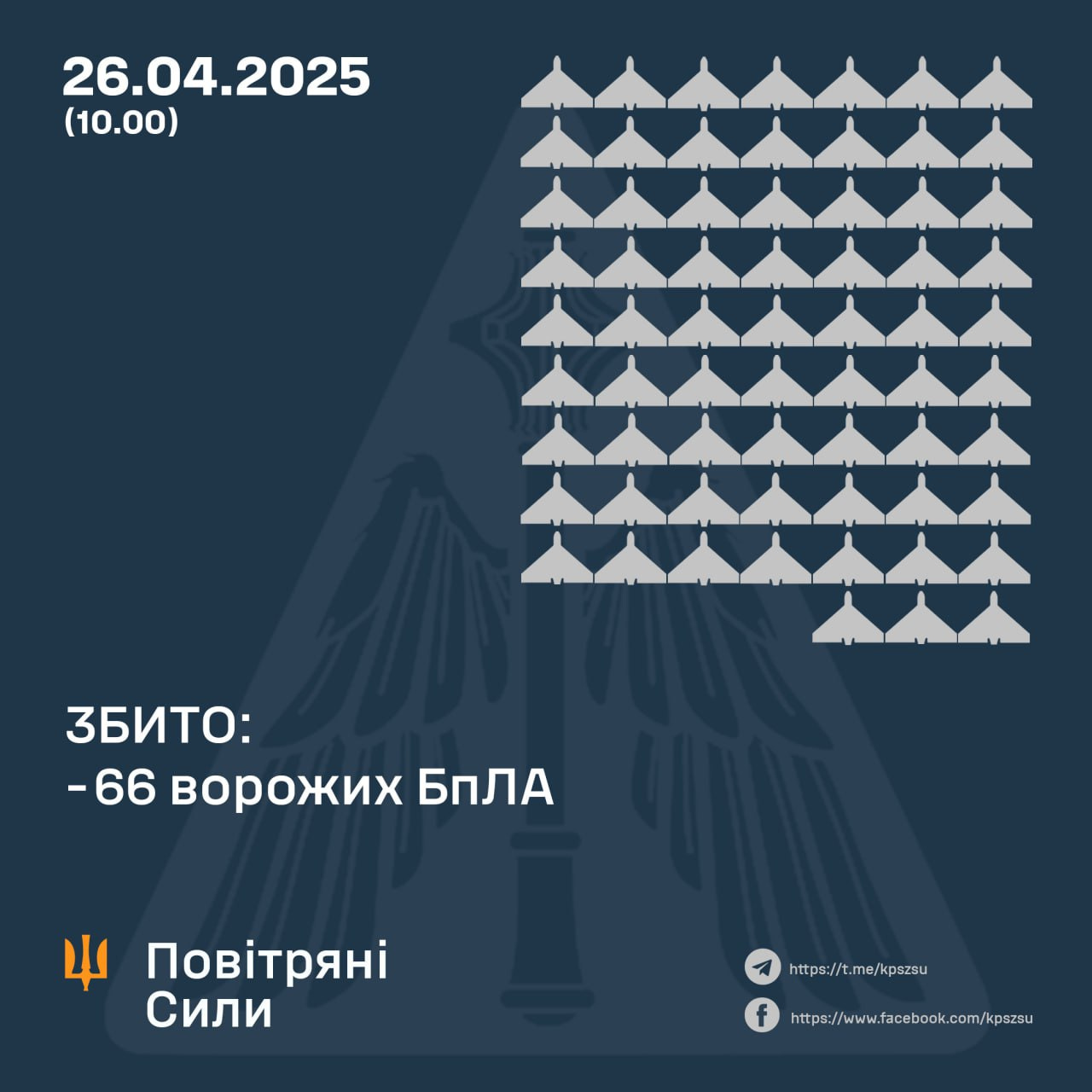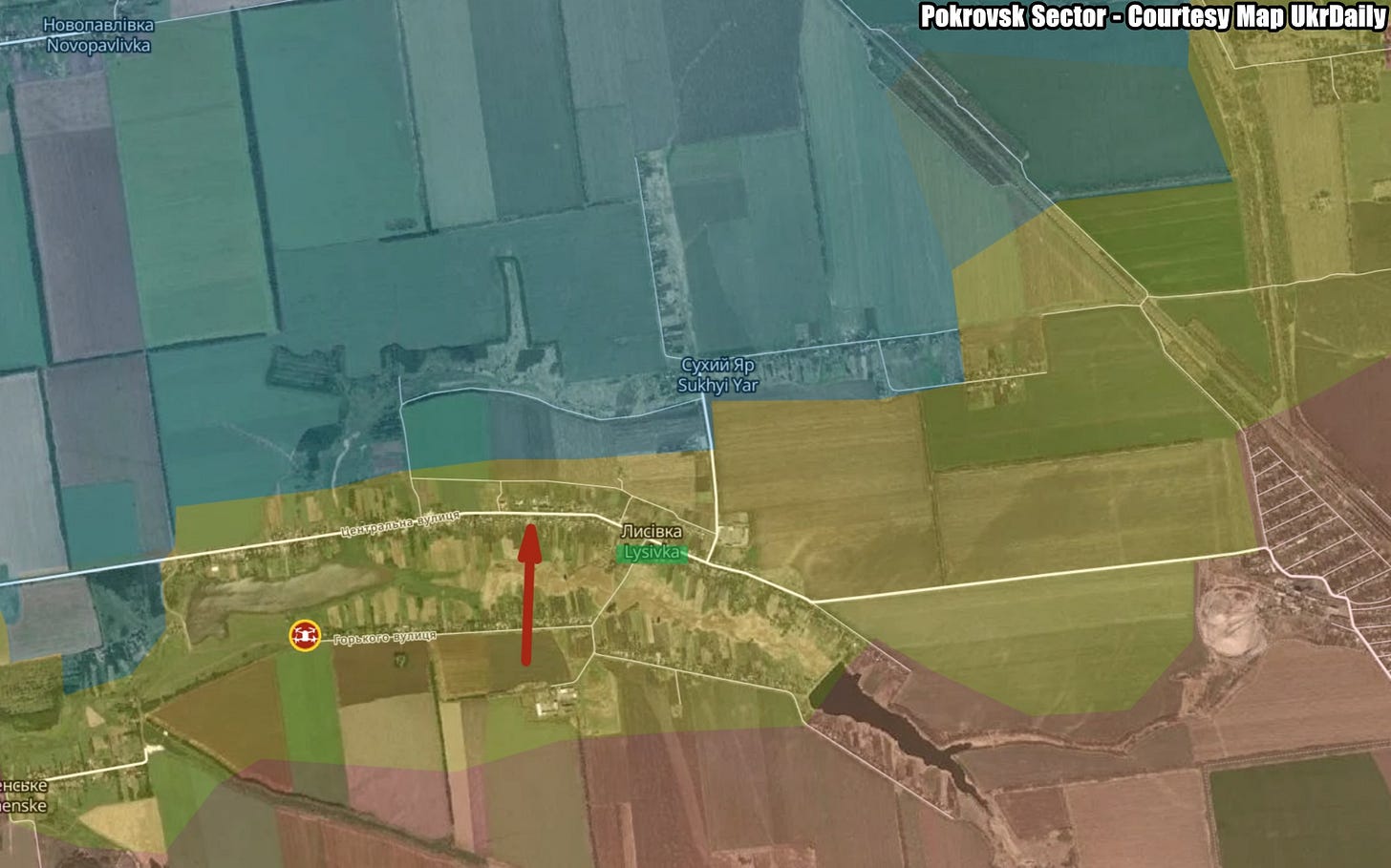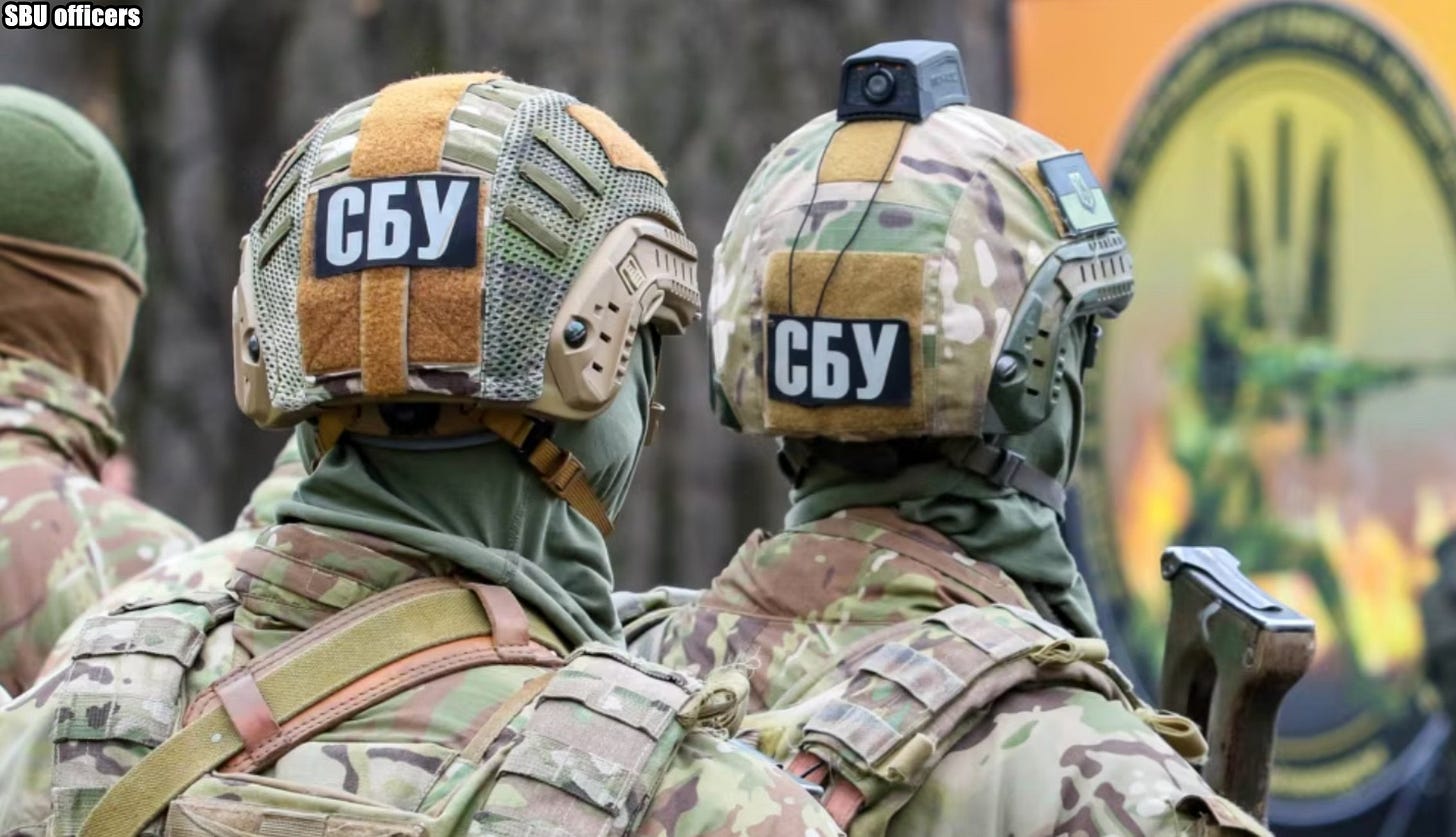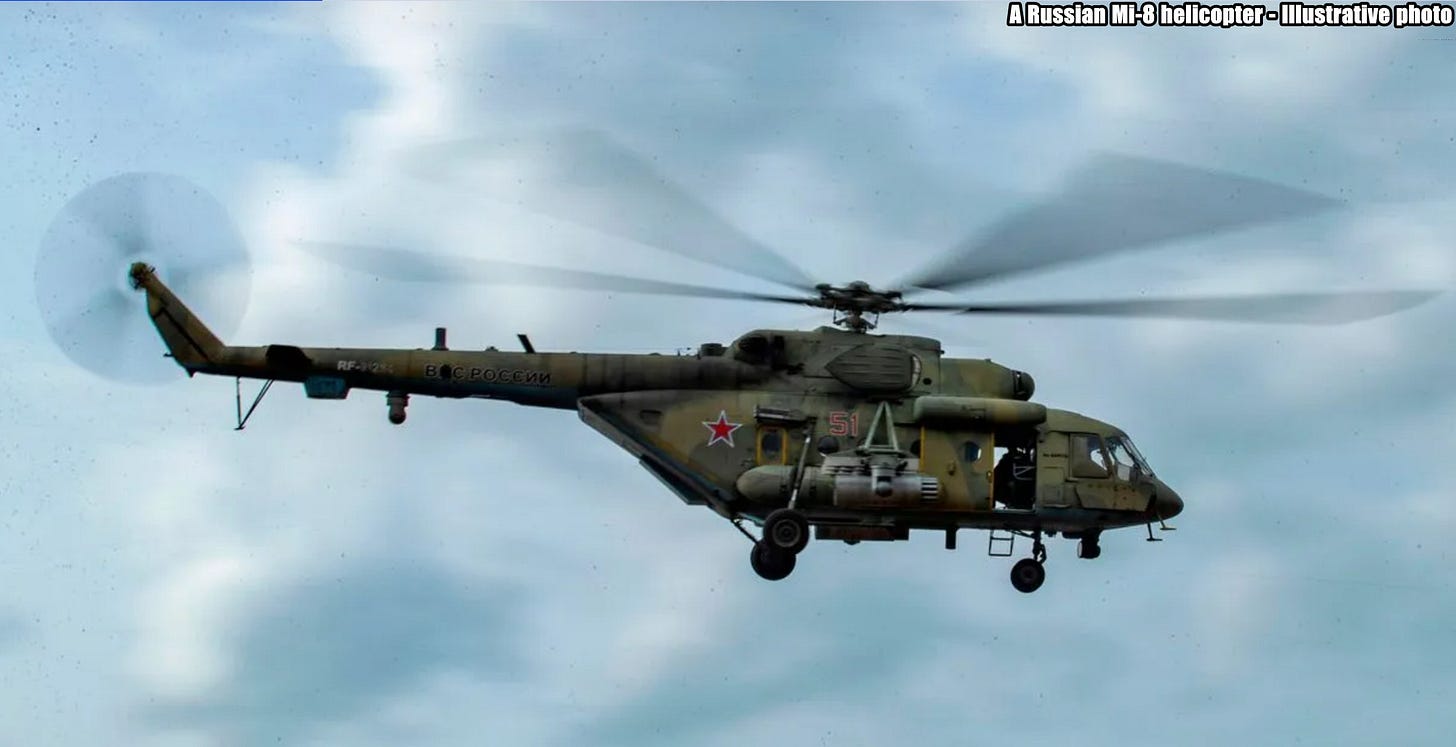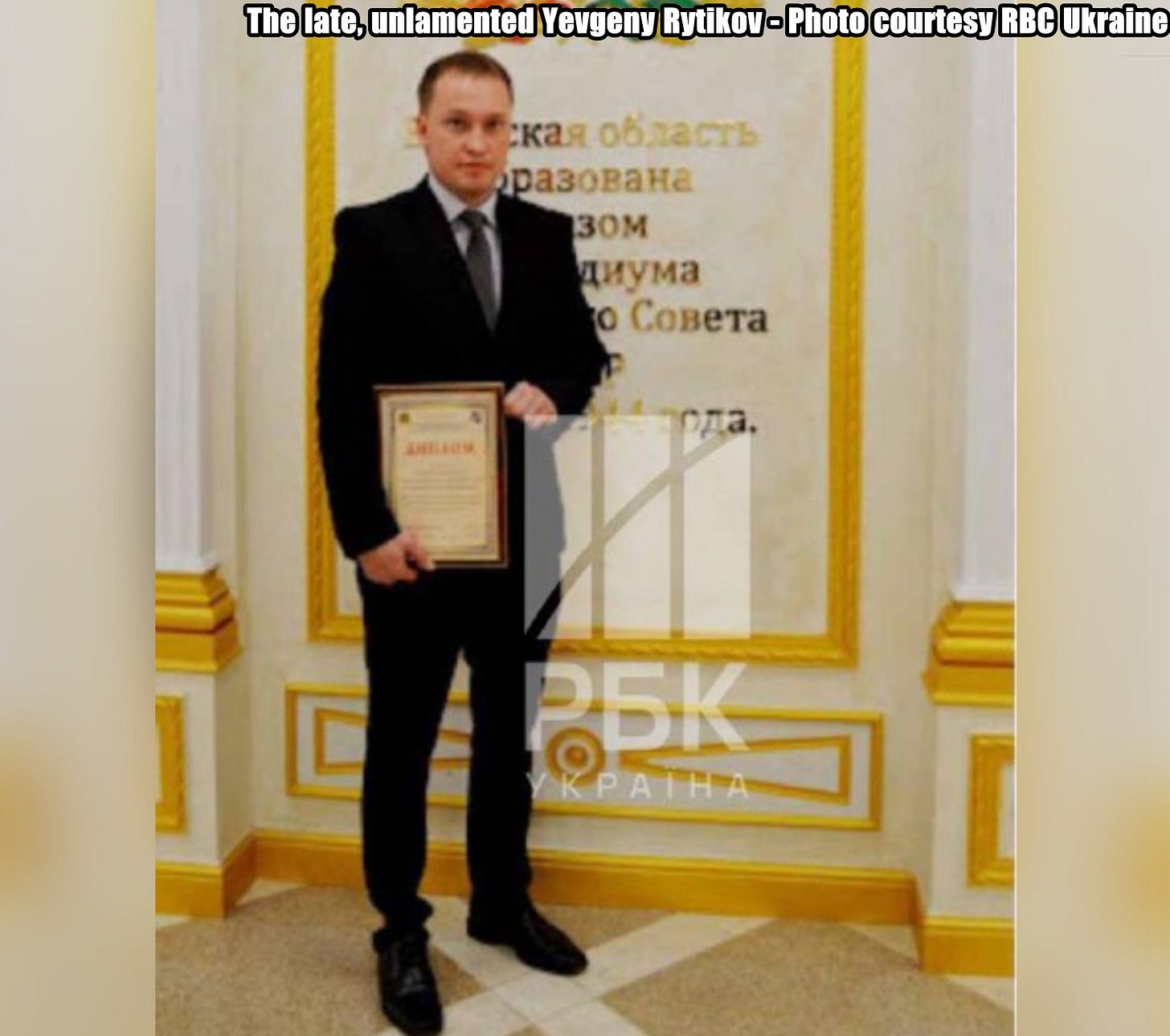Slava Ukraini! In early 2022 I began a Telegram channel aggregating news from a number of sources daily on the war in Ukraine. In June 2023 I began providing a daily draft for the Ukraine War Brief Podcast collecting news from over 70 sources daily, which formed the basis of the script. While the Podcast no longer exists I have continued to make this Brief available for my followers here on Substack for those who wish to keep up with the news from the war.
All the latest news on the Russo-Ukraine War 6 days per week
ALONG THE CONTACT LINE
GSAFU Morning Report
For: Apr 26, 2025
The General Staff of the Armed Forces of Ukraine in its Operational Information update at 08:00 on Apr 26 stated that day 1158 of the full-scale invasion of the Russian Federation against Ukraine had begun.
The situation on the line of combat remains tense in some sectors. Ukrainian defenders continue to actively counteract the Russian aggressor, causing them significant losses in personnel, equipment and technology. Exhausting the enemy along the entire front line and continuing to disrupt the plans of Russian occupiers to advance deeper into the territory of Ukraine.
During the past day, 156 combat engagements took place.
Over the past 24 hours, the enemy carried out 117 air strikes, used 3,363 drones and fired approximately 6,000 artillery shells across the positions of Ukrainian forces and civilians.
Air Force Daily Report
66 ENEMY UAVS SHOT DOWN, 31 SIMULATOR UAVS FAILED TO REACH THEIR TARGETS (LOCATIONALLY LOST)
➖➖➖➖➖➖➖➖➖
On the night of April 26, 2025 (from 10:00 p.m. on April 25), the enemy attacked with an Onyx anti-ship missile, two Kh-31P anti-radar missiles, and 114 strike UAVs (simulator drones of other types) - launch areas: Kursk, Millerovo, Orel, Primorsko-Akhtarsk - Russia.
The enemy air attack was repelled by aviation, anti-aircraft missile units, electronic warfare equipment, and mobile fire groups of the Defense Forces of Ukraine.
As of 10:00 AM, 66 Shahed attack UAVs (and other types of drones) have been confirmed shot down in the east, north, south, and center of the country.
31 enemy drone simulators — lost in location (without negative consequences).
As a result of the enemy attack, the Kirovohrad, Kharkiv, Kyiv, and Dnipropetrovsk regions suffered.
Combat Operations in the Russian Federation
The Institute for the Study of War (ISW), a US based think tank, in its Apr 25 Russian Offensive Campaign Assessment reported that:
Sumy - Kursk Border: Russian forces recently advanced near the international border in Kursk Oblast as part of efforts to push Ukrainian forces from their limited remaining positions in the area.
Geolocated footage published on Apr 24 indicates that Russian forces recently advanced north of Gornal (southwest of Sudzha). Additional geolocated footage published on Apr 25 shows that Russian forces reached the northeastern outskirts of Oleshnya (northwest of Gornal) during a reduced platoon-sized mechanized assault.
Belgorod Incursion: Fighting continued in northwestern Belgorod Oblast on Apr 25.
The Khortytsia operational-strategic group
(Responsible for the northeastern part of Ukraine. )
There have been no major changes to the combat environment since our last report.
The Tavria operational-strategic group
(Responsible for the central-eastern and southeastern part of Ukraine.)
Pokrovsk Sector : Russian forces recently advanced in the Pokrovsk direction.
Geolocated footage published on Apr 25 indicates that Russian forces advanced to southern Lysivka (southeast of Pokrovsk)
Zaporizhia Sector: Ukrainian forces recently advanced in western Zaporizhia Oblast.
Geolocated footage published on Apr 23 indicates that Ukrainian forces recently advanced in the southeastern outskirts of Mala Tokmachka (southeast of Orikhiv).
The Odesa operational-strategic group
(Responsible for Kherson, Qırım, (also known as Crimea) and the Black Sea.)
There have been no major changes to the combat environment since our last report.
TEMPORARILY OCCUPIED TERRITORIES
Nothing major to report.
THE HOME FRONT
Ukraine detains foreign vessel it says was exporting stolen grain.
Ukraine has detained a foreign vessel in its territorial waters which it alleges was involved in the illegal trade of stolen Ukrainian grain, the state security service SBU said on Friday, Reuters reports.
Kyiv has accused Russia of trading stolen Ukrainian grain since the 2022 war in Ukraine began, allegations Russia denies. Ship seizures, however, have been rare.
"The investigation found that the arrested vessel was part of Russia's 'shadow' fleet, which the Kremlin uses to sell looted Ukrainian grain to third countries," SBU said on the Telegram messaging service.
It said that at the end of 2024, the same vessel had exported from the Crimean port of Sevastopol 5,000 metric tons of wheat stolen from the occupied southern Ukrainian territory.
SBU said the vessel had carried out an illegal raid under the flag of an Asian country to export the grain. It gave no more details.
Last July Ukraine seized a foreign cargo ship on the Danube River and detained the captain on suspicion of helping Moscow export Ukrainian grain from Russian-occupied Crimea.
RUSSIAN WORLD
Interpol investigates Russian company for human trafficking over African workers in Tatarstan drone factory.
Interpol in Botswana began investigating Alabuga Start, billed in Africa as a work-study program in Russia for "ambitious young women" but linked to the production of military drones, for possible involvement with human trafficking, Bloomberg reported on April 25.
Since launching in 2022, Alabuga Start has recruited around 350 women from over 40 countries to work in Alabuga Special Economic Zone in Russia's Republic of Tatarstan and aims to bring 8,500 more this year, according to the article.
The head of Interpol's bureau in Gaborone, Detective Senior Superintendent Selebatso Mokgosi, said the investigation began after the company’s social media posts were brought to the organization’s attention.
Alabuga Special Economic Zone is an industrial complex dedicated to mechanical engineering and the production of Shahed kamikaze drones, as well as their Russian Geran copies, which Russia routinely uses in its attacks on Ukraine's civilian infrastructure.
Facing a labor shortage, Russia is trying to stuff its factories with outreach efforts in some of Africa’s poorest nations, denying that the workers are going to work in military production.
Alabuga Start is looking for women between the ages of 18 and 22 in countries like the Democratic Republic of Congo, South Sudan, Lesotho, but also in Botswana, one of Africa’s richest countries per capita that struggles with unemployment, Bloomberg writes.
The 2024 report by the non-profit Institute for Science and International Security estimated that "more than 90% of the Start program personnel" were assigned to drone assembly, aiming to produce 6,000 drones every year.
Last October, the Associated Press reported that African women were being forced to build drones in Alabuga under gruelling and hazardous conditions, and were paid much less than promised.
The in-depth investigations into Alabuga by Protokol, a Russian independent media outlet, showed that it has a track record of surveilling workers involved in drone manufacturing and keeping details about production in secret.
Last year, Ukraine confirmed attacking military facilities in Tatarstan at least twice with long-distance drone strikes. Most recently, Ukrainian drones reportedly struck the plant on April 23.
Before Alabuga Start ramped up recruitment abroad, the drones were assembled by students at the nearby vocational school, Alabuga Polytechnic. The students faced expulsion and the threat of fines ranging from 1.5 million to 2 million rubles ($18,000-$24,000) if they were found to have shared any information about their work, according to Bloomberg.
Ukrainian Drone Strikes Hit Shuya Missile Base for a Third Time This Month.
On the night of Friday, Apr 25, Russians reported a drone attack on the city of Shuya in the Ivanovo region of the Russian Federation, where the 112th Missile Brigade of the Russian Armed Forces is stationed, Defense Express reported.
Russian Telegram channels, citing residents of Shuya, report hearing explosions in the city.
At around 03:30 a.m., the authorities of the Ivanovo region reported an ongoing UAV attack in Shuya. Later, it was reported that "debris was falling" and that emergency services were working at the scene.
Local authorities also claim that there were no casualties.
The Russian Ministry of Defense stated that air defense allegedly shot down 79 drones overnight, including one over the Ivanovo region.
On Apr 16, Russians reported that the 112th Missile Brigade was attacked in Shuya, the same brigade that launched ballistic missiles at the city of Sumy on Palm Sunday. Local residents reported explosions, and footage showing drones flying overhead, an explosion in Shuya, and a column of smoke rising over the city was posted online.
RELATED INTERNATIONAL NEWS
Trump and Zelenskyy meet one-on-one in Vatican basilica to seek Ukraine peace.
U.S. President Donald Trump and Ukrainian leader Volodymyr Zelenskyy, in Rome for the funeral of Pope Francis, met one-on-one in a marble-lined Vatican basilica on Saturday to try to revive faltering efforts to end Russia's war with Ukraine, Reuters reports.
Zelenskyy said the meeting could prove historic if it delivers the kind of peace he is hoping for, and a White House spokesman called it "very productive".
The two leaders, leaning in close to each other with no aides around them while seated in St Peter's Basilica, spoke for about 15 minutes, according to Zelenskyy's office, which also released photographs of the meeting.
The meeting at the Vatican, their first since an angry encounter in the Oval Office in Washington in February, comes at a critical time in negotiations aimed at bringing an end to fighting between Ukraine and Russia.
In a post on social media platform Telegram, Zelenskyy wrote: "Good meeting. One-on-one, we managed to discuss a lot. We hope for a result from all the things that were spoken about."
He said those topics included: "The protection of the lives of our people. A complete and unconditional ceasefire. A reliable and lasting peace that will prevent a recurrence of war."
Zelenskyy added: "It was a very symbolic meeting that has the potential to become historic if we achieve joint results. Thank you, President Donald Trump!"
Steven Cheung, White House communications director, said the two leaders had met privately and had "a very productive discussion. More details about the meeting will follow".
In one photograph released by Zelenskyy's office, the Ukrainian and U.S. leaders sat opposite each other in a hall of the basilica, around two feet apart, and were leaning in towards each other in conversation. No aides could be seen in the image.
In a second photograph, from the same location, Zelenskyy, Trump, British Prime Minister Keir Starmer and French President Emmanuel Macron were shown standing in a tight huddle. Macron had his hand on Zelenskyy's shoulder.
After Trump and Zelenskyy met in the basilica, the two men joined other world leaders outside in Saint Peter's Square at the funeral service for Pope Francis, who made the pursuit of peace, including in Ukraine, a motif of his papacy.
Italian Cardinal Giovanni Battista Re, who gave the sermon at the funeral service, recalled how Pope Francis did not stop raising his voice to call for negotiations to end conflicts.
Trump, who has been pressing both sides to agree to a ceasefire, said on Friday that there had been productive talks between his envoy and the Russian leadership, and called for a high-level meeting between Kyiv and Moscow to close a deal.
Trump had previously warned both sides his administration would walk away from its efforts to achieve a peace if the two sides do not agree a deal soon.
The meeting in Rome is the first face-to-face encounter between Trump and Zelenskiy since an Oval Office meeting in February that turned into a shouting match.
The full text of the Ukrainian and European Peace Deal.
Released by Reuters
OFFICIAL-SENSITIVE
Russia-Ukraine Deal Framework
Ceasefire:
- Commit to a full and unconditional ceasefire in the sky, on land and at sea.
- Both sides immediately enter into negotiations on technical implementation with the participation of the US and European countries. This is in parallel to preparation of the agenda and modalities for a full peace deal.
-Ceasefire monitoring, led by the US and supported by third countries.
-Russia must unconditionally return all deported and illegally displaced Ukrainian children. Exchange of all prisoners of war (the principle of "all for all"). Russia must release all civilian prisoners.
Security guarantees for Ukraine:
-Ukraine receives robust security guarantees including from the US (Article 5-like agreement), while there is no consensus among Allies on NATO membership.
-No restrictions on the Ukrainian Defense Forces.
-The guarantor states will be an ad hoc group of European countries and willing non-European countries. No restrictions on the presence, weapons and operations of friendly foreign forces on the territory of Ukraine.
-Ukraine pursues accession to the EU.
Territory:
-Territorial issues will be discussed and resolved after a full and unconditional ceasefire.
-Territorial negotiations start from the basis of the line of control.
-Ukraine regains control of the Zaporizhzhia Nuclear Power Plant with US involvement, and also the Kakhovka Dam
-Ukraine enjoys unhindered passages on the Dnieper River and control of the KinburnSpit.
Economics:
-US and Ukraine implement economic cooperation/minerals agreement.
-Ukraine will be fully reconstructed and compensated financially, including through Russian sovereign assets that will remain frozen until Russia compensates damage to Ukraine.
-US sanctions imposed on Russia since 2014 may be subject to gradual easing after a sustainable peace is achieved and subject to resumption in the event of a breach of the peace agreement (snapback).
Russian military helicopter violates Polish airspace to probe air defenses
A Russian military helicopter of the Baltic Fleet violated Polish airspace on the evening of April 25, the Polish military command reported.
Polish military radar systems and civilian systems of the Polish Air Navigation Services Agency tracked the aircraft over Poland's territorial waters in the Baltic Sea.
"The nature of the incident indicates that Russia is testing the readiness of our air defense systems," the statement of the Polish Armed Forces Operational Command said on social media on Apr 26.
"On-duty air defense forces and means remained on constant alert to ensure the security of Polish airspace," the command added.
Poland has regularly scrambled jets since the start of Russia's full-scale invasion due to Russian missile and drone attacks on western Ukraine. In several cases, Russian projectiles have briefly entered the Polish airspace.
Warsaw has also repeatedly accused Russian aircraft of airspace violations. On Feb. 11, a Russian SU-24MR military jet flew within Polish airspace in the Gdansk bay area of the Baltic Sea for over a minute, due to what the Russian side said was a failure of the navigation system.
Last year, Polish Brigadier General Tomasz Drewniak told Radio RMF24 that Russia is likely testing Poland's air defenses after a suspected Russian drone flew into Polish airspace on Aug. 26 amid a mass attack on Ukraine.
MILITARY & TECH
Leading Designer of EW Systems in Russia Killed in Explosion.
In the Russian city of Bryansk, the car of a leading Russian designer, who was involved in the development and modernization of electronic warfare (EW) systems, exploded, RBC-Ukraine reported citing sources within the Defense Forces.
On the night of April 17-18, in Bryansk, the car of Russian designer Yevgeny Rytikov exploded. He was the head of the design bureau of the Bryansk Electromechanical Plant — a key developer and innovator in the sector of creating advanced EW systems for the Russian invasion army.
It is known that Rytikov’s car exploded when he and a colleague got into it. The publication suggests that the other person might have been the deputy head of the design bureau or his assistant.
The sources from the publication note that Rytikov was responsible, among other things, for the modernization of the Russian Krasukha EW systems.
Krasukha is a family of mobile, ground-based, electronic warfare systems designed to suppress and disrupt the operation of enemy radar stations and communication systems, including the radio channels used for controlling unmanned systems.
Russia uses two systems known as Krasukha-2 and Krasukha-4, which differ in the use of analog and modern digital components in the later version. The detailed technical specifications of these systems are classified, except for general information about their ability to cover large areas.
According to the developers, the system’s capabilities allow for effective counteraction against all modern radars used on aircraft of various types.
That’s it for today’s Brief folks if you would like to keep up with events in Ukraine daily please consider subscribing, it’s free!


